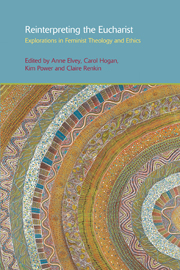Book contents
- Frontmatter
- Contents
- List of Illustrations
- Foreword
- Acknowledgements
- Contributors
- 1 Introduction
- 2 Eucharistic Metamorphosis: Changing Symbol, Changing Lives
- 3 The Sunday Eucharist: Embodying Christ in a Prophetic Act
- 4 How Australian Aboriginal Christian Womanist Tiddas (Sisters) Theologians Celebrate the Eucharist
- 5 Women, Eucharist, and Good News to All Creation in Mark
- 6 Rediscovering Forgotten Features: Scripture, Tradition and Whose Feet May Be Washed on Holy Thursday Night
- 7 Mystery Appropriated: Disembodied Eucharist and Meta-theology
- 8 Real Presence: Seeing, Touching, Tasting: Visualizing the Eucharist in Late Medieval Art
- 9 Embodying the Eucharist
- 10 Living One for the Other: Eucharistic Hospitality as Ecological Hospitality
- Subject Index
- Name Index
2 - Eucharistic Metamorphosis: Changing Symbol, Changing Lives
- Frontmatter
- Contents
- List of Illustrations
- Foreword
- Acknowledgements
- Contributors
- 1 Introduction
- 2 Eucharistic Metamorphosis: Changing Symbol, Changing Lives
- 3 The Sunday Eucharist: Embodying Christ in a Prophetic Act
- 4 How Australian Aboriginal Christian Womanist Tiddas (Sisters) Theologians Celebrate the Eucharist
- 5 Women, Eucharist, and Good News to All Creation in Mark
- 6 Rediscovering Forgotten Features: Scripture, Tradition and Whose Feet May Be Washed on Holy Thursday Night
- 7 Mystery Appropriated: Disembodied Eucharist and Meta-theology
- 8 Real Presence: Seeing, Touching, Tasting: Visualizing the Eucharist in Late Medieval Art
- 9 Embodying the Eucharist
- 10 Living One for the Other: Eucharistic Hospitality as Ecological Hospitality
- Subject Index
- Name Index
Summary
This essay traces the journey of a small dying congregation of Australian women religious—the Servants of the Blessed Sacrament— as they wrestled with the challenges of the Second Vatican Council's teaching on Eucharist and their ongoing renewal as a religious community. It is the community to which I am committed. The congregation's defining symbol, as their name suggests, is the Eucharist or the Blessed Sacrament. To the Eucharist the sisters return repeatedly to find the ‘holy Mystery of God’. In telling the story of this community, I will demonstrate how the core symbol of Eucharist, which embodies infinite meanings, has the power to give direction not only to a community's corporate identity and praxis, but also to a believing person's life commitment, choices, values, and relationships in a vastly expanding and rapidly changing post-modern, ecclesial and cultural context.
Context
The Australian congregation has its roots in nineteenth-century France. St Peter Julian Eymard (1811–1868), a French priest, founded two congregations: the Congregation of the Blessed Sacrament—the men's congregation—in Paris on 13 May 1856 and the Servants of the Blessed Sacrament—the women's congregation—in Angers on 31 July 1859. French sisters established the Canadian foundation in 1903. In August 1950, six French Canadian sisters and one Australian novice left Quebec, Canada, to begin the Melbourne foundation.
The Congregation's Constitutions, finally approved in 1885, unambiguously state its primary purpose:
This little religious family of our Holy Mother Church … is completely and whole-heartedly devoted, as to its primary end, to the rendering by all its members of a solemn and perpetual service of Adoration to our Lord Jesus Christ, ever dwelling in the Blessed Sacrament of the altar for love of mankind
(sic).- Type
- Chapter
- Information
- Reinterpreting the EucharistExplorations in Feminist Theology and Ethics, pp. 10 - 30Publisher: Acumen PublishingPrint publication year: 2012



